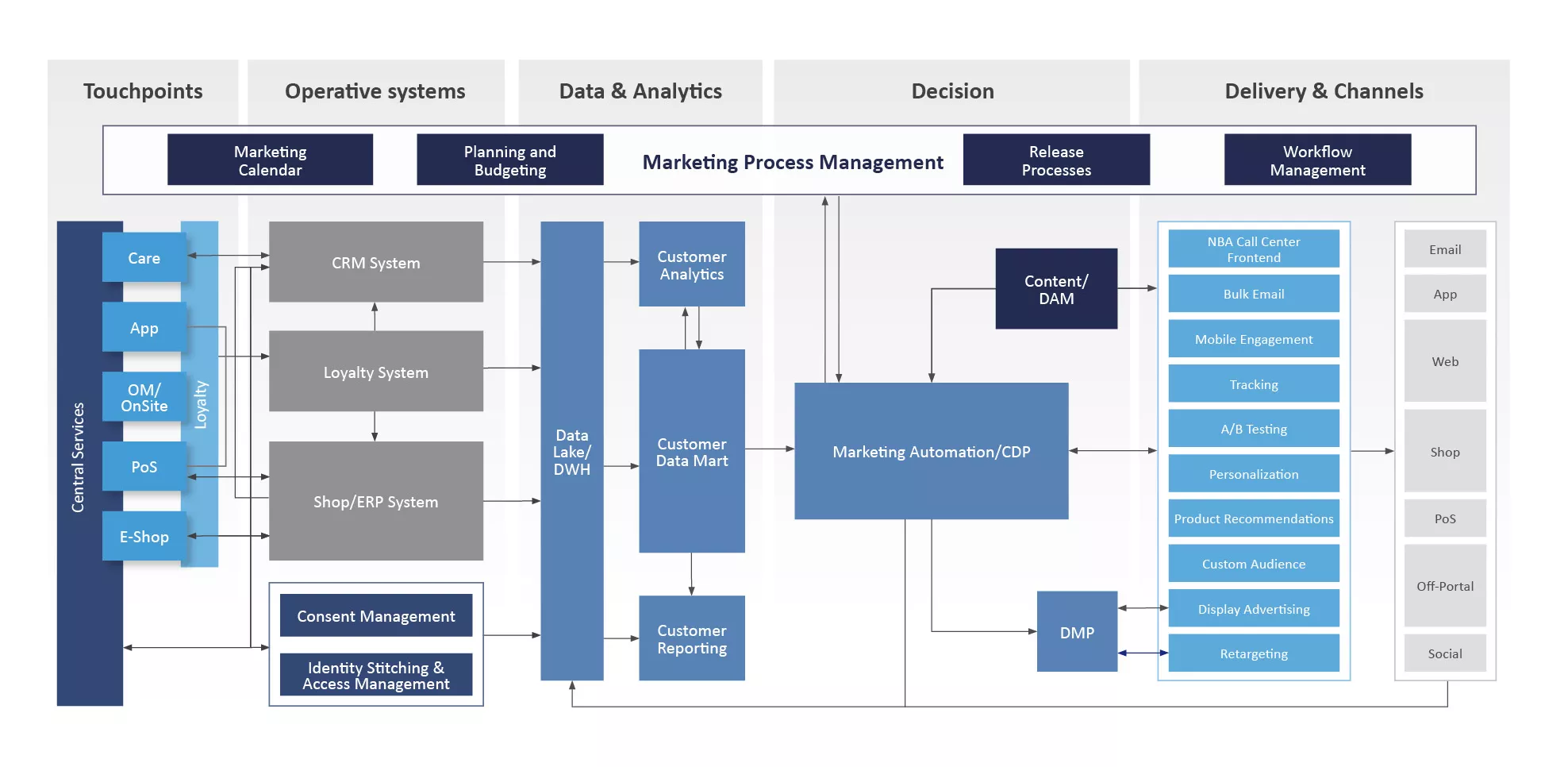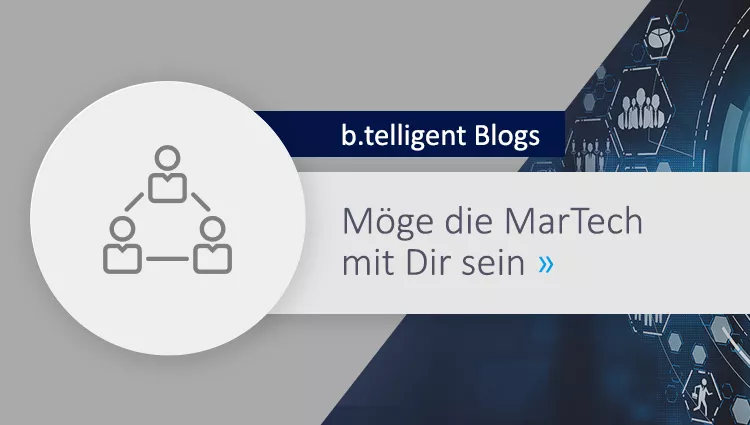In our series titled "The next generation of CRM – May the MarTech be with you", we have already explained the marketing technology trend's actual sustainability, the dos and don'ts to be observed during introduction, and the means of identifying one's own MarTech maturity level.
In this article, we will next take a look at the MarTech architecture – our map on the mission through the MarTech universe. Because precisely this aspect is becoming increasingly technical, complex and confusing. In our digital world, customers have numerous options at their disposal – and their demands in terms of customer experience are rising. But digitization is also bringing changes for marketers. Though the traces which customers leave behind along digital contact channels such as an online shop, app or website allow very versatile use – they also increase the complexity of marketing.
Everything at a glance: b.telligent's MarTech architecture
But how can this complexity be dealt with, solved and utilized? What is the best way to build a MarTech stack in your company? Which functions do you need at which points in your IT landscape, and how do you harmonize them? In response to these and many other questions about MarTech, b.telligent has developed its own MarTech architecture. It is technology-neutral and multi-layered, and therefore flexibly adaptable and extensible for every customer. And with its six sections, it's a map for orientation in the MarTech universe, showing your location as well as the tools and strategies needed at that point of the MarTech mission.

Marketing process management
In the marketing resource management section, all processes and measures accompanying campaigns are mapped and made available to management for central control and transparency. Marketing resource management includes functions such as planning and budgeting of all marketing measures, the related release processes, central workflow management and reporting of all key figures.
Touchpoints
Touchpoints are all the places where the customer comes into contact with your company, i.e. website, online shop, apps, etc. Because the important information flows here, there is also a lot to bear in mind with regard to data protection and GDPR. Especially as concerns the central services of consent management, identity & access management and loyalty, you must be able to inform customers at any time about the data which you have saved about them, and how you use these data. In addition, customers must be able to view and change their loyalty points and data, for example, via a self-service function such as "My account" – only this will give them the feeling of an optimal customer experience.
Operational systems
To allow disclosure and accounting, all this information at touchpoints should also be present in upstream operational systems such as CRM, call centre or an ERP system. The operational systems collect individual information such as master data, transactions, orders, permissions, etc., bring them together to provide a 360° view, perform analyses and only thus create real added value for your company.
Data & analytics
All this information is ultimately used in the data & analytics section, for example, in an upstream data lake. By analyzing customer profiles, forming statistical affinities, scoring and segmentation, and with the aid of artificial intelligence or machine learning, campaigns and target groups or their segments can be created and optimized precisely. Marketing automation comprises one of the most important use cases for the described 360° view. It utilizes consolidated information consisting of master data, purchasing behaviour, as well as data on clicks, permissions and responses to enrich automated campaign processes for customer-specific communication.
Decision
Decision here signifies the section in which marketing automation is used to decide which customer should be contacted with which offer via which channel with which incentive at what time of day etc. Furthermore, the workflow module or campaign designer is used to model the steps which customers are meant to go through within the campaign. Do they first receive an e-mail or push-message on their app? What would be the best time for further contacting, for example, for re-targeting after a shopping cart cancellation? How long should I wait to send a follow-up campaign to a customer? Does the customer react to personalized offers in the e-shop more readily than to push-messages in the mobile app? Such decisions are then made in the delivery & channels section.
Delivery & channels
Sending newsletters to customers is easy, it doesn't require an extensive MarTech architecture. But if you wish want to reap the rewards of your work in the other sections and precisely address customers on the basis of these findings, you then find yourself in the delivery & channels section. Now a 360° view of customers also proves its worth: Click data, redemption of coupons, purchases, opening rates – all this shows you the history, preferences and behaviour of your customers. Via the connected channels, you can accordingly broadcast personalized campaigns to your customers, test A/B variants and perform renewed measurements, or broadcast special product recommendations. Only a holistic view of the customer allows you to compile all knowledge and perform the correct derivations – and thus increase your campaign's long-term monetary success.
A scalable MarTech architecture offers all the possibilities
If you want to build a MarTech infrastructure for your company, we recommend that you plan and design it precisely in order to be successful. The most important consideration here: Which architecture matches your company's maturity? Because especially at the beginning, you might not need all functions, and can prioritize and scale as desired.
One should therefore begin with a realistic analysis of campaigns, processes and existing systems. Ask yourself: What are the strategic objectives? Can existent systems and data be used? Is there already a data lake or a customer-centric data mart in the company? Does the marketing automation solution currently in use meet my future requirements? If not, which future solution will suit me? Which channels do I currently use, and which ones will I have to add later?
This initial effort is worth it – don't shy away from it, and obtain support for this phase. Because once your MarTech architecture is in place, you are ideally equipped to enhance your customers' experience at the touchpoints noticeably, and to utilize their buying and clicking behaviour to optimize your marketing – demonstrating that your customers are not mere data points, but visitors and interested parties with specific needs.
Which areas of MarTech architecture already exist at your company? Which areas or functions are missing? Which ones should be established for your marketing in the short, medium or long term? Is your customer engagement ready? Contact us and join us in a quick check of the MarTech inventory!











